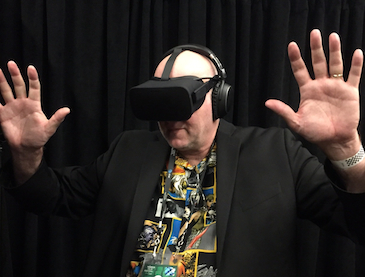CHICAGO – Excelsior! Comic book legend Stan Lee’s famous exclamation puts a fine point on the third and final play of Mark Pracht’s FOUR COLOR TRILOGY, “The House of Ideas,” presented by and staged at City Lit Theater in Chicago’s Edgewater neighborhood. For tickets/details, click HOUSE OF IDEAS.
Interview: Loren Hammonds, Programmer of Immersive Films at Tribeca Film Festival
CHICAGO – The future of story experience was on display at the recent 16th Tribeca Film Festival, and its popularity bodes well for the evolution of audience interaction. The “Virtual Arcade,” which was at the festival hub in the Tribeca neighborhood, featured Virtual Reality (VR), interactive storytelling and immersive experiences, which takes the participant into the world they once only watched. Loren Hammonds is the Programmer for these experiential works.
Loren Hammonds studied at a film conservatory at Purchase College in New York, and then worked in indie film production as a grip and production assistant. After curating at a video store in the West Village neighborhood of NYC, he made contacts at the Tribeca Film Festival. He has worked for the festival for nine years, programming films and evolving into the experiential realm.
Programmer Loren Hammonds of the Tribeca Film Festival Oversees the ‘Virtual Arcade’
Photo credit: Patrick McDonald for HollywoodChicago.com
HollywoodChicago.com talked to Hammonds in the midst of covering the Tribeca Film Festival.
HollywoodChicago.com: VR concepts have been around in theory and practice since the 1930s. What has been the recent breakthrough that made VR more practical and accessible?
Loren Hammonds: It’s started with mobile phone technology, and their powerful possessors, and how it helped innovators to understand 360 VR in a different way - it just needed a few more components. Add that to escalating processing power of computers, and it all made this possible.
HollywoodChicago.com: What is your background in evolving this technology, and how do you plan to stay involved in it?
Hammonds: My background is in film, I was a programmer here at Tribeca for six years. Five years ago, Ingrid Kopp introduced the Storyscapes into the festival. Eventually VR crept into that program, and interactive entertainment is something that is a personal interest and passion of mine. As VR became more prevalent, I wanted to get involved because it was such an interesting storytelling tool. As it expanded, I grew with it.
HollywoodChicago.com: Without going into too much detail, what is the current process for capturing VR concepts and presenting them as a finished work?
Hammonds: The creator and developer communities are taking radical approaches to each of these experiences. I’ve seen this process go from a paper deck presentation of concepts, to a two minute beginning experiment, to the addition of forms to enhance the presentation and bring it to life. Now to see it this far along, where additional effects are added like wind, smells or heat if necessary, it’s such an interesting result. It’s about creating a place, but then adding an additional 10,000 images to really capture a virtual environment. It seems now that sky is the limit, and it’s encouraging to talk to the creators and have them talk story first, and then working with the developers to deliver that story in the medium.
HollywoodChicago.com: What characterizes the Immersive Arcade at the Tribeca Film Festival, since you manage it?
Hammonds: When it’s really cooking, there are lines at all of the presentations. I think lately people are interested in the future of VR as something that isn’t necessarily isolating, with multi-person experiences becoming more popular.
HollywoodChicago.com: Obviously film exhibition is a next frontier for VR and immersive. Which studios are most interested, and when do you think theaters will add it to their options?
 The Interviewer Experiences the Immersive Photo credit: Patrick McDonald for HollywoodChicago.com |
Hammonds: First off, EVERY studio is interested. [laughs] But there interest has varied, for example, last year they saw it mostly as a marketing tool for the films themselves. Suddenly, in only one year, it’s about original content being developed. FOX Innovation is breaking new ground, partnering with creators who were in residence here last year, and that’s exciting, especially in anticipation of what kind of original content can be done. Asia is leading the way in exhibition, there are VR arcades all over China and Korea, even in movie theaters, and that is being noticed here.
HollywoodChicago.com: Besides entertainment, what are the practical applications for VR/Immersive in every day life?
Hammonds: There is so much… meditation, therapy, medicine and education to name a few. There are also presentations that are hybrids, a piece called ”Unrest,” that fosters empathy for a disability condition, to give people a feeling of what it may be like in real life. We have some ecological presentations here this year, they are calls to action and not just entertainment. There is so much potential.
HollywoodChicago.com: What is the new game changer for the next stage of this technology?
Hammonds: We’re all very interested to see how Augmented Reality [AR], AKA mixed reality, will work with VR. There is some concern about the isolating nature of VR, but AR allows you to see your environment along with the digital VR. I haven’t seen anything in AR that is super-strong storytelling yet, but as we’ve seen with VR the evolution came so quickly that I anticipate that the same can happen for AR.
HollywoodChicago.com: Personally, what do you want for an audience to take away from an immersive or VR demonstration?
Hammonds: I hope it will just allow for more diversity in storytelling. That’s what I’m most interested in, that creators and creative minds can use VR in different ways. I’m excited to see what will happen.
On PAGE TWO, Patrick McDonald reviews the Immersive/VR presentations he experienced at the 16th Tribeca Film Festival…


